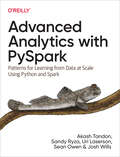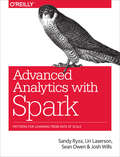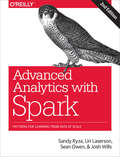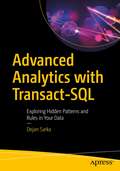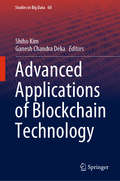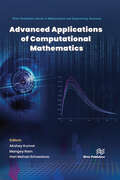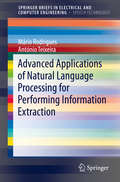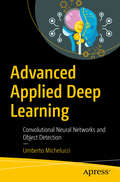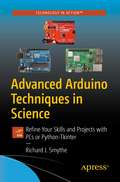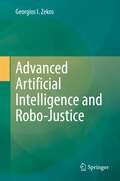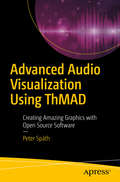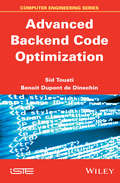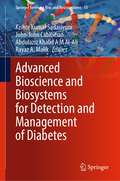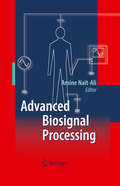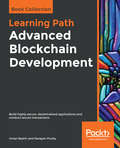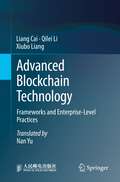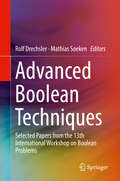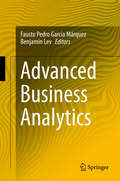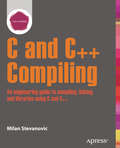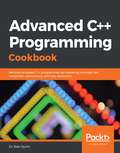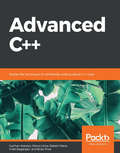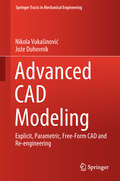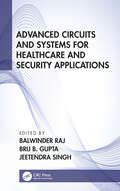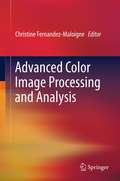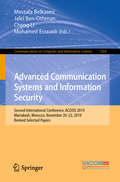- Table View
- List View
Advanced Analytics with PySpark: Patterns for Learning from Data at Scale Using Python and Spark
by Uri Laserson Josh Wills Sandy Ryza Sean Owen Akash TandonThe amount of data being generated today is staggering and growing. Apache Spark has emerged as the de facto tool to analyze big data and is now a critical part of the data science toolbox. Updated for Spark 3.0, this practical guide brings together Spark, statistical methods, and real-world datasets to teach you how to approach analytics problems using PySpark, Spark's Python API, and other best practices in Spark programming.Data scientists Akash Tandon, Sandy Ryza, Uri Laserson, Sean Owen, and Josh Wills offer an introduction to the Spark ecosystem, then dive into patterns that apply common techniques-including classification, clustering, collaborative filtering, and anomaly detection, to fields such as genomics, security, and finance. This updated edition also covers NLP and image processing.If you have a basic understanding of machine learning and statistics and you program in Python, this book will get you started with large-scale data analysis.Familiarize yourself with Spark's programming model and ecosystemLearn general approaches in data scienceExamine complete implementations that analyze large public datasetsDiscover which machine learning tools make sense for particular problemsExplore code that can be adapted to many uses
Advanced Analytics with Spark
by Uri Laserson Josh Wills Sandy Ryza Sean OwenIn this practical book, four Cloudera data scientists present a set of self-contained patterns for performing large-scale data analysis with Spark. The authors bring Spark, statistical methods, and real-world data sets together to teach you how to approach analytics problems by example.You'll start with an introduction to Spark and its ecosystem, and then dive into patterns that apply common techniques--classification, collaborative filtering, and anomaly detection among others--to fields such as genomics, security, and finance. If you have an entry-level understanding of machine learning and statistics, and you program in Java, Python, or Scala, you'll find these patterns useful for working on your own data applications.Patterns include:Recommending music and the Audioscrobbler data setPredicting forest cover with decision treesAnomaly detection in network traffic with K-means clusteringUnderstanding Wikipedia with Latent Semantic AnalysisAnalyzing co-occurrence networks with GraphXGeospatial and temporal data analysis on the New York City Taxi Trips dataEstimating financial risk through Monte Carlo simulationAnalyzing genomics data and the BDG projectAnalyzing neuroimaging data with PySpark and Thunder
Advanced Analytics with Spark: Patterns for Learning from Data at Scale
by Uri Laserson Josh Wills Sandy Ryza Sean OwenIn the second edition of this practical book, four Cloudera data scientists present a set of self-contained patterns for performing large-scale data analysis with Spark. The authors bring Spark, statistical methods, and real-world data sets together to teach you how to approach analytics problems by example. Updated for Spark 2.1, this edition acts as an introduction to these techniques and other best practices in Spark programming.You’ll start with an introduction to Spark and its ecosystem, and then dive into patterns that apply common techniques—including classification, clustering, collaborative filtering, and anomaly detection—to fields such as genomics, security, and finance.If you have an entry-level understanding of machine learning and statistics, and you program in Java, Python, or Scala, you’ll find the book’s patterns useful for working on your own data applications.With this book, you will:Familiarize yourself with the Spark programming modelBecome comfortable within the Spark ecosystemLearn general approaches in data scienceExamine complete implementations that analyze large public data setsDiscover which machine learning tools make sense for particular problemsAcquire code that can be adapted to many uses
Advanced Analytics with Transact-SQL: Exploring Hidden Patterns and Rules in Your Data
by Dejan SarkaLearn about business intelligence (BI) features in T-SQL and how they can help you with data science and analytics efforts without the need to bring in other languages such as R and Python. This book shows you how to compute statistical measures using your existing skills in T-SQL. You will learn how to calculate descriptive statistics, including centers, spreads, skewness, and kurtosis of distributions. You will also learn to find associations between pairs of variables, including calculating linear regression formulas and confidence levels with definite integration. No analysis is good without data quality. Advanced Analytics with Transact-SQL introduces data quality issues and shows you how to check for completeness and accuracy, and measure improvements in data quality over time. The book also explains how to optimize queries involving temporal data, such as when you search for overlapping intervals. More advanced time-oriented information in the book includes hazard and survival analysis. Forecasting with exponential moving averages and autoregression is covered as well. Every web/retail shop wants to know the products customers tend to buy together. Trying to predict the target discrete or continuous variable with few input variables is important for practically every type of business. This book helps you understand data science and the advanced algorithms use to analyze data, and terms such as data mining, machine learning, and text mining.Key to many of the solutions in this book are T-SQL window functions. Author Dejan Sarka demonstrates efficient statistical queries that are based on window functions and optimized through algorithms built using mathematical knowledge and creativity. The formulas and usage of those statistical procedures are explained so you can understand and modify the techniques presented. T-SQL is supported in SQL Server, Azure SQL Database, and in Azure Synapse Analytics. There are so many BI features in T-SQL that it might become your primary analytic database language. If you want to learn how to get information from your data with the T-SQL language that you already are familiar with, then this is the book for you. What You Will LearnDescribe distribution of variables with statistical measuresFind associations between pairs of variablesEvaluate the quality of the data you are analyzingPerform time-series analysis on your dataForecast values of a continuous variablePerform market-basket analysis to predict customer purchasing patternsPredict target variable outcomes from one or more input variablesCategorize passages of text by extracting and analyzing keywordsWho This Book Is ForDatabase developers and database administrators who want to translate their T-SQL skills into the world of business intelligence (BI) and data science. For readers who want to analyze large amounts of data efficiently by using their existing knowledge of T-SQL and Microsoft’s various database platforms such as SQL Server and Azure SQL Database. Also for readers who want to improve their querying by learning new and original optimization techniques.
Advanced Applications of Blockchain Technology (Studies in Big Data #60)
by Ganesh Chandra Deka Shiho KimThis contributed volume discusses diverse topics to demystify the rapidly emerging and evolving blockchain technology, the emergence of integrated platforms and hosted third-party tools, and the development of decentralized applications for various business domains. It presents various applications that are helpful for research scholars and scientists who are working toward identifying and pinpointing the potential of as well as the hindrances to this technology.
Advanced Applications of Computational Mathematics: Theoretical Advances And Advanced Applications (De Gruyter Series On The Applications Of Mathematics In Engineering And Information Sciences Ser. #3)
by Mangey Ram Akshay Kumar Hari Mohan SrivastavaThis book “Advanced Applications of Computational Mathematics” covers multidisciplinary studies containing advanced research in the field of computational and applied mathematics. The book includes research methodology, techniques, applications, and algorithms. The book will be very useful to advanced students, researchers and practitioners who are involved in the areas of computational and applied mathematics and engineering.
Advanced Applications of Natural Language Processing for Performing Information Extraction (SpringerBriefs in Speech Technology)
by António Teixeira Mário RodriguesThis book explains how can be created information extraction (IE) applications that are able to tap the vast amount of relevant information available in natural language sources: Internet pages, official documents such as laws and regulations, books and newspapers, and social web. Readers are introduced to the problem of IE and its current challenges and limitations, supported with examples. The book discusses the need to fill the gap between documents, data, and people, and provides a broad overview of the technology supporting IE. The authors present a generic architecture for developing systems that are able to learn how to extract relevant information from natural language documents, and illustrate how to implement working systems using state-of-the-art and freely available software tools. The book also discusses concrete applications illustrating IE uses. · Provides an overview of state-of-the-art technology in information extraction (IE), discussing achievements and limitations for the software developer and providing references for specialized literature in the area · Presents a comprehensive list of freely available, high quality software for several subtasks of IE and for several natural languages · Describes a generic architecture that can learn how to extract information for a given application domain
Advanced Applied Deep Learning: Convolutional Neural Networks and Object Detection
by Umberto MichelucciDevelop and optimize deep learning models with advanced architectures. This book teaches you the intricate details and subtleties of the algorithms that are at the core of convolutional neural networks. In Advanced Applied Deep Learning, you will study advanced topics on CNN and object detection using Keras and TensorFlow. Along the way, you will look at the fundamental operations in CNN, such as convolution and pooling, and then look at more advanced architectures such as inception networks, resnets, and many more. While the book discusses theoretical topics, you will discover how to work efficiently with Keras with many tricks and tips, including how to customize logging in Keras with custom callback classes, what is eager execution, and how to use it in your models. Finally, you will study how object detection works, and build a complete implementation of the YOLO (you only look once) algorithm in Keras and TensorFlow. By the end of the book you will have implemented various models in Keras and learned many advanced tricks that will bring your skills to the next level.What You Will Learn See how convolutional neural networks and object detection workSave weights and models on diskPause training and restart it at a later stage Use hardware acceleration (GPUs) in your codeWork with the Dataset TensorFlow abstraction and use pre-trained models and transfer learningRemove and add layers to pre-trained networks to adapt them to your specific projectApply pre-trained models such as Alexnet and VGG16 to new datasets Who This Book Is For Scientists and researchers with intermediate-to-advanced Python and machine learning know-how. Additionally, intermediate knowledge of Keras and TensorFlow is expected.
Advanced Arduino Techniques in Science: Refine Your Skills and Projects with PCs or Python-Tkinter
by Richard J. SmytheIf you’re already a comfortable programmer, familiar with your single board computer and microcontroller, and are ready to refine your projects, then let’s get started! This book covers advanced methods and techniques for creating, implementing, monitoring and controlling your experiments and projects with your Raspberry Pi and Arduino. Projects will use Python and the Tkinter GUI and will also cover software development for adding real time data display to the Raspberry Pi.You'll review concepts of frequency occurring in nature and the techniques used to measure the frequency of electrically varying signal voltages. You'll also study procedures for safe design, implementation and operation of experimental measurement systems operating at high heats and high temperatures. Throughout the book you'll look at sources and types of errors, and best practices for minimizing and reducing them.Often times there are simple environmental issues hindering what would seem to be simple projects: high temperatures, controlling the power for elevated temperature with the proportional integral and derivative (PID) algorithm, and the limitations imposed by eight bit code, the influence of noise and errors in measured data, and many more. Advanced Arduino Techniques in Science provides the best tools to move past those restrictions. What You’ll LearnImplement an experimental control system and graphical data display for the Raspberry Pi and ArduinoManage experimental control with PID algorithm implementation, tuning and limitations imposed by eight bit digital signalsBuild an analytical front end Examine data smoothing capability of the Kalman filterExplore available methods for measuring both high and low frequency values in electronic signalsWho This Book Is ForEducators, researchers, students, makers, citizen scientists, or hobbyists can all extend their measuring capability or improve upon the quality of their collected data. The book is directed to those with intermediate skills in programming and those who are comfortable with Python programming and Arduino C.
Advanced Artificial Intelligence and Robo-Justice
by Georgios I. ZekosThe book deals with digital technology which is transforming the landscape of dispute resolution. It illustrates the application of AI in the legal field and shows the future prospect of robo-justice for an AAI society in the advanced artificial intelligence era. In other words, the present justice system and the influence of current AI upon courts and arbitration are investigated. The transforming role of AI on all legal fields is examined thoroughly by giving answers concerning AI legal personality and liability. The analysis shows that digital technology is generating an ever-growing number of disputes and at the same time is challenging the effectiveness and reach of traditional dispute resolution avenues. To that extent, the book presents in tandem the impact of AI upon courts and arbitration, and reveals the role of AAI in generating a new robo-justice system.Finally, the end of the perplexing relation of courts and arbitration is evidenced methodically and comprehensively.
Advanced Audio Visualization Using ThMAD: Creating Amazing Graphics with Open Source Software
by Peter SpäthLearn advanced techniques and improve your audio visualization skills with Thinking Machine Audio Dreams (ThMAD). With this book, you can concentrate on advanced examples and usage patterns, including using shaders in a more profound way, and how to incorporate ThMAD into a tool chain using the professional sound server JACK.
Advanced Backend Code Optimization
by Sid Touati Benoit Dupont de DinechinThis book is a summary of more than a decade of research in the area of backend optimization. It contains the latest fundamental research results in this field. While existing books are often more oriented toward Masters students, this book is aimed more towards professors and researchers as it contains more advanced subjects.It is unique in the sense that it contains information that has not previously been covered by other books in the field, with chapters on phase ordering in optimizing compilation; register saturation in instruction level parallelism; code size reduction for software pipelining; memory hierarchy effects and instruction level parallelism.Other chapters provide the latest research results in well-known topics such as register need, and software pipelining and periodic register allocation.
Advanced Bioscience and Biosystems for Detection and Management of Diabetes (Springer Series on Bio- and Neurosystems #13)
by Kishor Kumar Sadasivuni John-John Cabibihan Rayaz A. Malik Abdulaziz Khalid A M Al-AliThis book covers the medical condition of diabetic patients, their early symptoms and methods conventionally used for diagnosing and monitoring diabetes. It describes various techniques and technologies used for diabetes detection. The content is built upon moving from regressive technology (invasive) and adapting new-age pain-free technologies (non-invasive), machine learning and artificial intelligence for diabetes monitoring and management. This book details all the popular technologies used in the health care and medical fields for diabetic patients. An entire chapter is dedicated to how the future of this field will be shaping up and the challenges remaining to be conquered. Finally, it shows artificial intelligence and predictions, which can be beneficial for the early detection, dose monitoring and surveillance for patients suffering from diabetes
Advanced Biosignal Processing
by Amine Nait-AliThrough 17 chapters, this book presents the principle of many advanced biosignal processing techniques. After an important chapter introducing the main biosignal properties as well as the most recent acquisition techniques, it highlights five specific parts which build the body of this book. Each part concerns one of the most intensively used biosignals in the clinical routine, namely the Electrocardiogram (ECG), the Elektroenzephalogram (EEG), the Electromyogram (EMG) and the Evoked Potential (EP). In addition, each part gathers a certain number of chapters related to analysis, detection, classification, source separation and feature extraction. These aspects are explored by means of various advanced signal processing approaches, namely wavelets, Empirical Modal Decomposition, Neural networks, Markov models, Metaheuristics as well as hybrid approaches including wavelet networks, and neuro-fuzzy networks. The last part, concerns the Multimodal Biosignal processing, in which we present two different chapters related to the biomedical compression and the data fusion. Instead organising the chapters by approaches, the present book has been voluntarily structured according to signal categories (ECG, EEG, EMG, EP). This helps the reader, interested in a specific field, to assimilate easily the techniques dedicated to a given class of biosignals. Furthermore, most of signals used for illustration purpose in this book can be downloaded from the Medical Database for the Evaluation of Image and Signal Processing Algorithm. These materials assist considerably the user in evaluating the performances of their developed algorithms. This book is suited for final year graduate students, engineers and researchers in biomedical engineering and practicing engineers in biomedical science and medical physics.
Advanced Blockchain Development: Build highly secure, decentralized applications and conduct secure transactions
by Narayan Prusty Imran BashirExplore distributed ledger technology, decentralization, and smart contracts and develop real-time decentralized applications with Ethereum and SolidityKey FeaturesGet to grips with the underlying technical principles and implementations of blockchainBuild powerful applications using Ethereum to secure transactions and create smart contractsGain advanced insights into cryptography and cryptocurrenciesBook DescriptionBlockchain technology is a distributed ledger with applications in industries such as finance, government, and media. This Learning Path is your guide to building blockchain networks using Ethereum, JavaScript, and Solidity. You will get started by understanding the technical foundations of blockchain technology, including distributed systems, cryptography and how this digital ledger keeps data secure. Further into the chapters, you’ll gain insights into developing applications using Ethereum and Hyperledger. As you build on your knowledge of Ether security, mining , smart contracts, and Solidity, you’ll learn how to create robust and secure applications that run exactly as programmed without being affected by fraud, censorship, or third-party interference. Toward the concluding chapters, you’ll explore how blockchain solutions can be implemented in applications such as IoT apps, in addition to its use in currencies. The Learning Path will also highlight how you can increase blockchain scalability and even discusses the future scope of this fascinating and powerful technology. By the end of this Learning Path, you'll be equipped with the skills you need to tackle pain points encountered in the blockchain life cycle and confidently design and deploy decentralized applications.This Learning Path includes content from the following Packt products:Mastering Blockchain - Second Edition by Imran BashirBuilding Blockchain Projects by Narayan PrustyWhat you will learnUnderstand why decentralized applications are importantDiscover the mechanisms behind bitcoin and alternative cryptocurrenciesMaster how cryptography is used to secure data with the help of examplesMaintain, monitor, and manage your blockchain solutionsCreate Ethereum walletsExplore research topics and the future scope of blockchain technologyWho this book is forThis Learning Path is designed for blockchain developers who want to build decentralized applications and smart contracts from scratch using Hyperledger. Basic familiarity with any programming language will be useful to get started with this Learning Path.
Advanced Blockchain Technology: Frameworks and Enterprise-Level Practices
by Liang Cai Qilei Li Xiubo LiangThis book is a must-have for blockchain developers who want to learn from scratch how to leverage blockchain technology in a real-world setting. The first section provides a brief overview of blockchain technology, including its concepts, history, technology genre, major related companies and typical application scenarios, and presents an ecological map for the blockchain industry by comparing and analyzing some mainstream platforms.The second section systematically introduces Ethereum and HyperLedger, exemplars of well-known open-source blockchain platforms, and demonstrates how to conduct blockchain applications development based on the two platforms.The third section illustrates core technology of enterprise blockchain platforms (to take Hyperchain, an independent, controllable blockchain alliance as an example), and covers Hyperchain based enterprise blockchain applications development technology.The fourth section presents 6 actual blockchain-based applications examples, and analyzes applications development procedure and related key codes. Examples in this book are of great practicability and operability, allowing practitioners to get started easily, and eventually utilize these skills to develop real-life, usable blockchain applications.
Advanced Boolean Techniques: Selected Papers from the 13th International Workshop on Boolean Problems
by Rolf Drechsler Mathias SoekenThis book describes recent findings in the domain of Boolean logic and Boolean algebra, covering application domains in circuit and system design, but also basic research in mathematics and theoretical computer science. Content includes invited chapters and a selection of the best papers presented at the 13th annual International Workshop on Boolean Problems.Provides a single-source reference to the state-of-the-art research in the field of logic synthesis and Boolean techniques;Includes a selection of the best papers presented at the 13th annual International Workshop on Boolean Problems;Covers Boolean algebras, Boolean logic, Boolean modeling, Combinatorial Search, Boolean and bitwise arithmetic, Software and tools for the solution of Boolean problems, Applications of Boolean logic and algebras, Applications to real-world problems, Boolean constraint solving, and Extensions of Boolean logic.
Advanced Business Analytics
by Fausto Pedro García Márquez Benjamin LevThe book describes advanced business analytics and shows how to apply them to many different professional areas of engineering and management. Each chapter of the book is contributed by a different author and covers a different area of business analytics. The book connects the analytic principles with business practice and provides an interface between the main disciplines of engineering/technology and the organizational, administrative and planning abilities of management. It also refers to other disciplines such as economy, finance, marketing, behavioral economics and risk analysis. This book is of special interest to engineers, economists and researchers who are developing new advances in engineering management but also to practitioners working on this subject.
Advanced C and C++ Compiling
by Milan StevanovicLearning how to write C/C++ code is only the first step. To be a serious programmer, you need to understand the structure and purpose of the binary files produced by the compiler: object files, static libraries, shared libraries, and, of course, executables. Advanced C and C++ Compiling explains the build process in detail and shows how to integrate code from other developers in the form of deployed libraries as well as how to resolve issues and potential mismatches between your own and external code trees. With the proliferation of open source, understanding these issues is increasingly the responsibility of the individual programmer. Advanced C and C++ Compiling brings all of the information needed to move from intermediate to expert programmer together in one place -- an engineering guide on the topic of C/C++ binaries to help you get the most accurate and pertinent information in the quickest possible time. What you'll learn The details of the build process, including compiling and linking The inner workings of static libraries, shared libraries, and executables Ways to properly architect code for smooth integration of future changes Tips for troubleshooting problems with compiling and linking as well as run-time problems How to use operating system-specific (Linux and Windows) tools for analysis of binary files Who this book is for C/C++ software designers aspiring to senior levels, software architects, build engineers, and Linux system administrators. Table of ContentsMultitasking OS Basics Simple Program Lifetime StagesProgram Execution StagesThe Impact of Reusing ConceptWorking with Static Libraries Designing Dynamic Libraries: BasicsLocating the LibrariesDesigning Dynamic Libraries: Advanced TopicsHandling Duplicate Symbols When Linking In Dynamic LibrariesDynamic Libraries Versioning Dynamic Libraries Miscellaneous TopicsThe Linux ToolboxLinux TasksWindows Toolbox"
Advanced C++ Programming Cookbook: Become an expert C++ programmer by mastering concepts like templates, concurrency, and type deduction
by Dr. Rian QuinnA recipe-based guide to refining your C++ programming skills with the help of coding best practices, advanced programming concepts, and the latest features of C++17 and C++20 Key Features Learn how to develop and design your own libraries Find solutions to your app development problems and implement them in a highly reusable manner, following library development best practices Explore advanced C++ features such as containers, coroutines, and modules Book Description If you think you've mastered C++ and know everything it takes to write robust applications, you'll be in for a surprise. With this book, you'll gain comprehensive insights into C++, covering exclusive tips and interesting techniques to enhance your app development process. You'll kick off with the basic principles of library design and development, which will help you understand how to write reusable and maintainable code. You'll then discover the importance of exception safety, and how you can avoid unexpected errors or bugs in your code. The book will take you through the modern elements of C++, such as move semantics, type deductions, and coroutines. As you advance, you'll delve into template programming - the standard tool for most library developers looking to achieve high code reusability. You'll explore the STL and learn how to avoid common pitfalls while implementing templates. Later, you'll learn about the problems of multithreaded programming such as data races, deadlocks, and thread starvation. You'll also learn high-performance programming by using benchmarking tools and libraries. Finally, you'll discover advanced techniques for debugging and testing to ensure code reliability. By the end of this book, you'll have become an expert at C++ programming and will have gained the skills to solve complex development problems with ease. What you will learn Solve common C++ development problems by implementing solutions in a more generic and reusable way Achieve different levels of exception safety guarantees by introducing precise declarations Write library-quality code that meets professional standards Practice writing reliable, performant code that exposes consistent behavior in programs Understand why you need to implement design patterns and how it's done Work with complex examples to understand various aspects of good library design Who this book is for This book is for intermediate and expert-level C++ developers who are looking to explore the lesser known functionalities of the language to improve the efficiency of their code and the way they develop applications. Basic knowledge of object-oriented programming concepts and the Standard Template Library (STL) is assumed.
Advanced C++: Master the technique of confidently writing robust C++ code
by Brian Price Vivek Nagarajan Gazihan Alankus Olena Lizina Rakesh ManeBecome an expert at C++ by learning all the key C++ concepts and working through interesting exercises Key Features Explore C++ concepts through descriptive graphics and interactive exercises Learn how to keep your development bug-free with testing and debugging Discover various techniques to optimize your code Book Description C++ is one of the most widely used programming languages and is applied in a variety of domains, right from gaming to graphical user interface (GUI) programming and even operating systems. If you're looking to expand your career opportunities, mastering the advanced features of C++ is key. The book begins with advanced C++ concepts by helping you decipher the sophisticated C++ type system and understand how various stages of compilation convert source code to object code. You'll then learn how to recognize the tools that need to be used in order to control the flow of execution, capture data, and pass data around. By creating small models, you'll even discover how to use advanced lambdas and captures and express common API design patterns in C++. As you cover later chapters, you'll explore ways to optimize your code by learning about memory alignment, cache access, and the time a program takes to run. The concluding chapter will help you to maximize performance by understanding modern CPU branch prediction and how to make your code cache-friendly. By the end of this book, you'll have developed programming skills that will set you apart from other C++ programmers. What you will learn Delve into the anatomy and workflow of C++ Study the pros and cons of different approaches to coding in C++ Test, run, and debug your programs Link object files as a dynamic library Use templates, SFINAE, constexpr if expressions and variadic templates Apply best practice to resource management Who this book is for If you have worked in C++ but want to learn how to make the most of this language, especially for large projects, this book is for you. A general understanding of programming and knowledge of using an editor to produce code files in project directories is a must. Some experience with strongly typed languages, such as C and C++, is also recommended.
Advanced CAD Modeling: Explicit, Parametric, Free-form Cad And Re-engineering (Springer Tracts in Mechanical Engineering)
by Jože Duhovnik Nikola VukašinovićThe book discusses the theoretical fundamentals of CAD graphics to enhance readers’ understanding of surface modeling and free-form design by demonstrating how to use mathematical equations to define curves and surfaces in CAD modelers. Additionally, it explains and describes the main approaches to creating CAD models out of 3D scans of physical objects. All CAD approaches are demonstrated with guided examples and supported with comprehensive engineering explanations. Furthermore, each approach includes exercises for independent consolidation of advanced CAD skills. This book is intended for engineers and designers who are already familiar with the basics of modern CAD tools, e.g. feature based and solid based modeling in 3D space, and would like to improve and expand their knowledge and experience. It is also an easy-to use guide and excellent teaching and research aid for academics and practitioners alike.
Advanced Circuits and Systems for Healthcare and Security Applications
by Brij B. Gupta Balwinder Raj Jeetendra SinghVLSI devices downscaling is a very significant part of the design to improve the performance of VLSI industry outcomes, which results in high speed and low power of operation of integrated devices. The increasing use of VLSI circuits dealing with highly sensitive information, such as healthcare information, means adequate security measures are required to be taken for the secure storage and transmission. Advanced Circuits and Systems for Healthcare and Security Applications provides broader coverage of the basic aspects of advanced circuits and security and introduces the corresponding principles. By the end of this book, you will be familiarized with the theoretical frameworks, technical methodologies, and empirical research findings in the field to protect your computers and information from adversaries. Advanced circuits and the comprehensive material of this book will keep you interested and involved throughout. The book is an integrated source which aims at understanding the basic concepts associated with the security of the advanced circuits and the cyber world as a first step towards achieving high-end protection from adversaries and hackers. The content includes theoretical frameworks and recent empirical findings in the field to understand the associated principles, key challenges and recent real-time applications of the advanced circuits and cybersecurity. It illustrates the notions, models, and terminologies that are widely used in the area of circuits and security, identifies the existing security issues in the field, and evaluates the underlying factors that influence the security of the systems. It emphasizes the idea of understanding the motivation of the attackers to establish adequate security measures and to mitigate security attacks in a better way. This book also outlines the exciting areas of future research where the already-existing methodologies can be implemented. Moreover, this book is suitable for students, researchers, and professionals in the who are looking forward to carry out research in the field of advanced circuits and systems for healthcare and security applications; faculty members across universities; and software developers.
Advanced Color Image Processing and Analysis
by Christine Fernandez-MaloigneThis volume does much more than survey modern advanced color processing. Starting with a historical perspective on ways we have classified color, it sets out the latest numerical techniques for analyzing and processing colors, the leading edge in our search to accurately record and print what we see. The human eye perceives only a fraction of available light wavelengths, yet we live in a multicolor world of myriad shining hues. Colors rich in metaphorical associations make us "purple with rage" or "green with envy" and cause us to "see red." Defining colors has been the work of centuries, culminating in today's complex mathematical coding that nonetheless remains a work in progress: only recently have we possessed the computing capacity to process the algebraic matrices that reproduce color more accurately. With chapters on dihedral color and image spectrometers, this book provides technicians and researchers with the knowledge they need to grasp the intricacies of today's color imaging.
Advanced Communication Systems and Information Security: Second International Conference, ACOSIS 2019, Marrakesh, Morocco, November 20–22, 2019, Revised Selected Papers (Communications in Computer and Information Science #1264)
by Cheng Li Mostafa Belkasmi Jalel Ben-Othman Mohamed EssaaidiThis book constitutes selected papers of the Second International Conference on Advanced Communication Systems and Information Security, ACOSIS 2019, held in Marrakesh, Morocco, in November 2019.The 10 full papers and 10 short papers were thoroughly reviewed and selected from 94 submissions. The papers are organized accroding to the following topical sections: wireless communications and services; vehicular communications; channel coding; construction of error correcting codes; intrusion detection techniques; wireless and mobile network security; applied cryptography.
